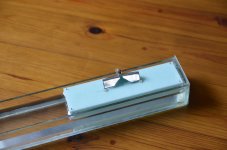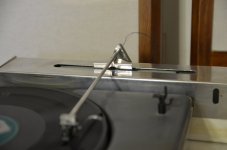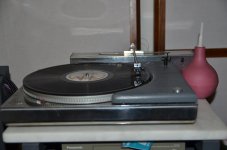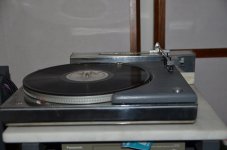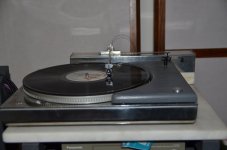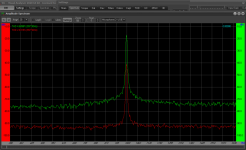I was thinking that the main pivot bearing would be as you have in the photos and the rail that supports the counterbalance spring could be a right angle, the same as used in the terminator arm. This would prevent the counterbalance from rotating.I just now realized what you mean, yes-that's an interesting idea.
But unfortunately in my case is not realizable, because I use only a half-cylinder as a movable carriage.
I thought a little more🙂.I was thinking that the main pivot bearing would be as you have in the photos and the rail that supports the counterbalance spring could be a right angle, the same as used in the terminator arm. This would prevent the counterbalance from rotating.
In my case, you can do your version, but the tonearm carriage itself should be installed not on top of the air tube, but at the bottom of it, and then everything will work out.
In this case, when the spring is installed in front of the main rail, you need less air flow from the compressor, and it's important, the less air pressure, the less noise from it. I have adjustable air flow and I make its minimal flow, just so the two parts don't rub against each other.
The only disadvantage of this design is that all of it will be visible, and in another case it would be hidden behind the turntable.
But maybe if the whole design will be in sight, and it will look cooler🙂.
Here you go. But I have never tried it so I can't tell you too much about it. At least, it doesn't need a secondary air supply and it is frictionless.Hi.
To be honest, I can't imagine how to attach a magnet there and most importantly how to adjust the tracking force of the tonearm with it.
Can you draw a diagram?
View attachment 1059905
Thank you, now I get it, it's a beautiful solution.
With your style of air bearing it is indeed important to keep the air pressure as low as possible.I thought a little more🙂.
In my case, you can do your version, but the tonearm carriage itself should be installed not on top of the air tube, but at the bottom of it, and then everything will work out.
In this case, when the spring is installed in front of the main rail, you need less air flow from the compressor, and it's important, the less air pressure, the less noise from it. I have adjustable air flow and I make its minimal flow, just so the two parts don't rub against each other.
The only disadvantage of this design is that all of it will be visible, and in another case it would be hidden behind the turntable.
But maybe if the whole design will be in sight, and it will look cooler🙂.
The pressure in the air-gap will be constant regardless of supply pressure. A higher supply pressure will just increase the gap. This will make the "air-spring" effectively longer. A longer spring, of the same material, will have a greater compliance. By making the air gap smaller you make the bearing stiffer which will raise its resonant frequency. A higher resonant frequency is easier to damp and will have fewer harmonics within the audio band.
I think having the whole design visible looks much cooler, form following function never looks bad.
Magnets can be a bit tricky with edge effects complicating matters. I did some calculations and found that stability was a real concern with anything I could envisage. Thing is, sometimes you are dealing with a cube law IIRC.
But then again, with Niffy's reflex clamp, warps are not an issue, and so it just might work after all.
But then again, with Niffy's reflex clamp, warps are not an issue, and so it just might work after all.
I was inspired by the following thread.
https://www.diyaudio.com/community/...ter-weight-pseudo-magnetic-levitation.374342/
Please also watch Warren's video.
https://www.diyaudio.com/community/...ter-weight-pseudo-magnetic-levitation.374342/
Please also watch Warren's video.
Last edited:
I didn't write here that before I made a parallel tonearm on an air bearing I made the same tonearm on a water bearing, it was very interesting 🙂.
The essence: a glass, rectangular tank filled with water, and on the surface a foam float with knife rollers made of fluoroplastic on needle bush bearings.
That is the whole mass of the tone arm is on the float, and the pulling force of the plate groove pushes the float with the tone arm through the rollers to the glass wall of the "aquarium".
It works without any problems and the main thing is that the sound is very good, maybe even better than on the air bearing.
A little later I will go to the attic and find these parts, I saved them just in case.
Yes, the vertical movement of the tone arm is done with knives.
The essence: a glass, rectangular tank filled with water, and on the surface a foam float with knife rollers made of fluoroplastic on needle bush bearings.
That is the whole mass of the tone arm is on the float, and the pulling force of the plate groove pushes the float with the tone arm through the rollers to the glass wall of the "aquarium".
It works without any problems and the main thing is that the sound is very good, maybe even better than on the air bearing.
A little later I will go to the attic and find these parts, I saved them just in case.
Yes, the vertical movement of the tone arm is done with knives.
Water would damp the arm more effectively than air due to its higher viscosity. Most air-bearing arms use a high (compared to air or water) silicone fluid to add damping. Maybe the combined damping of air and silicone is similar to water in your experimental arm.I didn't write here that before I made a parallel tonearm on an air bearing I made the same tonearm on a water bearing, it was very interesting 🙂.
The essence: a glass, rectangular tank filled with water, and on the surface a foam float with knife rollers made of fluoroplastic on needle bush bearings.
That is the whole mass of the tone arm is on the float, and the pulling force of the plate groove pushes the float with the tone arm through the rollers to the glass wall of the "aquarium".
It works without any problems and the main thing is that the sound is very good, maybe even better than on the air bearing.
A little later I will go to the attic and find these parts, I saved them just in case.
Yes, the vertical movement of the tone arm is done with knives.
Hello.Water would damp the arm more effectively than air due to its higher viscosity. Most air-bearing arms use a high (compared to air or water) silicone fluid to add damping. Maybe the combined damping of air and silicone is similar to water in your experimental arm.
I somehow fell out of love with the air bearing, put the tonearm on a fixed plate, turned on the compressor and listened ...
I climbed into the attic and searched for my first tangential tonearm on the water for a long time, I searched for a very long time. But I found it and then I remembered how I switched from it to an air one and noticed that the air one lost in sound, but I was so carried away by the air bearing that I neglected the first and very important sound impressions.
I am restoring it, it takes time and hard work, you yourself know this.
Attachments
The tonearm already pleases my ear.
The principle of operation is very simple, the entire mass of the tonearm is on a float made of dense foam (density 60). The water in the aquarium is distilled.
when you put the needle on the record, the track of the record attracts the float with PTFE knife rollers (a very slippery material) to the thick glass aquarium wall.
The tonearm itself is mounted on a float by means of knives for two washers with slots made of caprolon. That's it.
The sound is very good.
The aquarium is installed on a double plate of marble, the player also stands on the marble through iron balls.
Everything is level adjustable.
The principle of operation is very simple, the entire mass of the tonearm is on a float made of dense foam (density 60). The water in the aquarium is distilled.
when you put the needle on the record, the track of the record attracts the float with PTFE knife rollers (a very slippery material) to the thick glass aquarium wall.
The tonearm itself is mounted on a float by means of knives for two washers with slots made of caprolon. That's it.
The sound is very good.
The aquarium is installed on a double plate of marble, the player also stands on the marble through iron balls.
Everything is level adjustable.
Attachments
Water is not a good medium at all. There are three problems with your design.
1. Water has resistance. The friction may be larger than you think.
2. The accuracy of the wheels and the wall of the water container is problematic.
3. The arm base floats on the water. It may be slightly up and down. This is not desirable.
1. Water has resistance. The friction may be larger than you think.
2. The accuracy of the wheels and the wall of the water container is problematic.
3. The arm base floats on the water. It may be slightly up and down. This is not desirable.
Here they offered something other than water, glycerin for example, but precisely because water is very malleable, I used it, we must immediately consider the purpose for which it is used, if we are talking about a speedboat, then yes, water will resist.Water is not a good medium at all. There are three problems with your design.
1. Water has resistance. The friction may be larger than you think.
2. The accuracy of the wheels and the wall of the water container is problematic.
3. The arm base floats on the water. It may be slightly up and down. This is not desirable.
Knife wheels have a very small area of contact with the ideal glass surface, they are also attached to thin stainless steel axles, in the working position they are moistened with water, so they work out the eccentricity fabulously, it's nice just to look at it (I'll shoot a video 🙂.
The float is large enough and does not sink in water, when loaded, the water level does not even reach half of its thickness of the foam material. Yes, and there are no such loads to change its position in the vertical, there is only a load in the horizontal, this is the sound track of a rotating plate pulling the tonearm .
So your comments are more theoretical than practical 🙂.
A distinctive feature in the sound of this tonearm is greater accuracy in high frequencies, as well as more pronounced low frequencies.
I believe the water support is interesting to consider. i had looked at it myself.Here they offered something other than water, glycerin for example, but precisely because water is very malleable, I used it, we must immediately consider the purpose for which it is used, if we are talking about a speedboat, then yes, water will resist.
Knife wheels have a very small area of contact with the ideal glass surface, they are also attached to thin stainless steel axles, in the working position they are moistened with water, so they work out the eccentricity fabulously, it's nice just to look at it (I'll shoot a video 🙂.
The float is large enough and does not sink in water, when loaded, the water level does not even reach half of its thickness of the foam material. Yes, and there are no such loads to change its position in the vertical, there is only a load in the horizontal, this is the sound track of a rotating plate pulling the tonearm .
So your comments are more theoretical than practical 🙂.
A distinctive feature in the sound of this tonearm is greater accuracy in high frequencies, as well as more pronounced low frequencies.
One of the main objections to air is that it acts as a spring as it compresses and doesnt ground the arm at all, but sits it on a spring, which would be contrary to most good practices, in principle, water is not compressible and should in some circumstances be better than air. If one considers the axes and movement of this arm and its rotation i believe there are some that would seem satisfactory and others maybe not.
Starting with linear movement of the cariage, the pull from resistance of the stylus in the groove is resisted by the wheels against the ptfe, a soft material, hard materials would seem better and probably lower reistance, one would expect a greater precision to the sound as a result.
Horizontal movement as the stylus tracks the record, the float moves across the bath, should when considered alone be low resistance, a small float in water will not have much resistance, but maybe try measuring it like Carlo has? A long thin float will have less resistance than a short wide/deep one. Surface area is also critical.
Vertical movement will be like a spring, as you all know the weight of the float will be supported by displaced water and equilibrium will be reached after some displacement after a series of oscilations, not desirable but could always actually be a better compromise than some others.
By the way any such movement will also affect VTA, but one then has to wonder why it would occur in any case. Rotational movements will have some similarities, looking down on the assembly, if the arrangement remains in equilibrium with the stylus drag and the bath edge it cannot rotate. from the view of the face of the cartridge there may be all sorts going on! - the resistance to rotation will depend on the waterplane of the float and its disposition, resistance to it will be greatest with a large waterplane spread well away from the arm wand. i suspect this will be the worst aspect of the arrangement and the stylus will not be working against a reasonably fixed location. If the float were very long with waterplane at its ends it would be best for this and other aspects. Looking from the side, one has a reasonably common set of limitations.
The long arm wand of all devices with the carriage at the back of the turntable is quite possibly as much of a limitation, again, have a look at Carlos RTA's which eliminate the limitations in this respect.
Always interesting to see and consider new ideas!!
M
Guys, I beg your pardon, but many do not understand how the aqua arm works.
Nothing special happens in the aquarium, there is no storm, and I don’t have to wipe the foam coming out through the edges of the aquarium. On the contrary, everything is absolutely calm, complete calm.
Nothing special happens in the aquarium, there is no storm, and I don’t have to wipe the foam coming out through the edges of the aquarium. On the contrary, everything is absolutely calm, complete calm.
Guys, I beg your pardon, but many do not understand how the aqua arm works.
Nothing special happens in the aquarium, there is no storm, and I don’t have to wipe the foam coming out through the edges of the aquarium. On the contrary, everything is absolutely calm, complete calm.
Correct Havun, I don't understand much, I was just trying to give your ideas some support and explore areas that you might latch on to for further improvements (i can imagine a series of simple improvements you could make), also to encourage folk to add to this thread.
In my lack of understanding I depend a little on the thousands of experiments and measurements I have done with RTA's and surprised myself many times when something I believed would improve things and I perceived to be better, actually measured worse, have you tried measuring anything?
It's quite simple and I can dig out some guides (that others gave to me) if you are interested. My arm measures quite well now, and to me sounds good too, it measures much better than quite well reputed commercial arms. I got there by being open minded and listening to other people's ideas and thinking carefully.
Things moving in water is something I have a vague understanding of as well.
Hope your experiments go well!
M
In my lack of understanding I depend a little on the thousands of experiments and measurements I have done with RTA's and surprised myself many times when something I believed would improve things and I perceived to be better, actually measured worse, have you tried measuring anything?
It's quite simple and I can dig out some guides (that others gave to me) if you are interested. My arm measures quite well now, and to me sounds good too, it measures much better than quite well reputed commercial arms. I got there by being open minded and listening to other people's ideas and thinking carefully.
Things moving in water is something I have a vague understanding of as well.
Hope your experiments go well!
M
Mike, what do you mean by measurements - the main resonance of the arm arm?, so if it does not kick out of the groove, this means that the frequency is within the norm.
If you mean by measuring the load of the side walls of the groove, then it is enough to look at the behavior of the cantilever during the development of eccentricity, if it bends at the same time, then the load on the moving parts of the tonearm is too large?
I looked carefully at the behavior of the cantilever (very pliable in this head), it does not bend at all.
If you mean by measuring the load of the side walls of the groove, then it is enough to look at the behavior of the cantilever during the development of eccentricity, if it bends at the same time, then the load on the moving parts of the tonearm is too large?
I looked carefully at the behavior of the cantilever (very pliable in this head), it does not bend at all.
It would of course be interesting to see a video of the cantilever in warp and in eccentricities as well. Measurements that have demonstrated well to me are of the output from the preamp on a 1khz test tone from a test record through an ADC to a computer-based analyser programme. I use Visual Analyser. This test has clearly demonstrated to me many times small improvements that are difficult to discern individually by ear and also shown when i imagined something sounded good that it was actually worse, perhaps like when you enjoyed your air bearing for the wrong reasons?Mike, what do you mean by measurements - the main resonance of the arm arm?, so if it does not kick out of the groove, this means that the frequency is within the norm.
If you mean by measuring the load of the side walls of the groove, then it is enough to look at the behavior of the cantilever during the development of eccentricity, if it bends at the same time, then the load on the moving parts of the tonearm is too large?
I looked carefully at the behavior of the cantilever (very pliable in this head), it does not bend at all.
A recent measurement looks like SS1453, a poor start point looks like the other - 83! - note also the change in scales
Attachments
- Home
- Source & Line
- Analogue Source
- DIY linear tonearm
